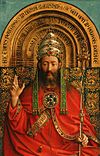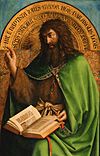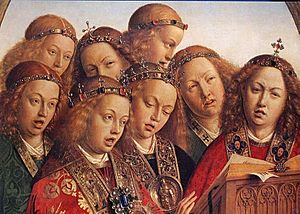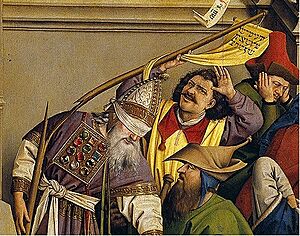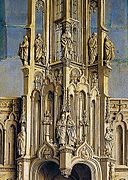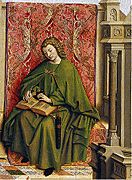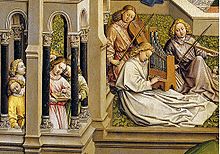The Fountain of Life (painting) facts for kids
The Fountain of Life is a beautiful and old painting made with oil on a wooden panel around the year 1432. It is also sometimes called The Fountain of Grace and the Triumph of the Church over the Synagogue. For most of its history, this painting has been in Spain, and today you can see it at the Museo del Prado in Madrid.
This painting is very similar in style and theme to the work of a famous artist named Jan van Eyck. However, it doesn't have his signature, so experts have different ideas about who exactly painted it. Some think Jan van Eyck painted it himself, maybe when he was on a trip to Spain. But other studies suggest it was painted in the Netherlands, perhaps in van Eyck's workshop, after someone in Spain asked for it.
The Fountain of Life looks a lot like parts of another famous artwork from 1432 called the Ghent Altarpiece, which was made by Jan van Eyck and his brother Hubert. Most experts agree that the painting was created in a workshop, but they still debate if it was by a young Jan, his brother Hubert, or even a later artist like Petrus Christus.
The painting is set up in three main parts, like different levels. The top part shows God the Son, the Virgin Mary, and St. John the Evangelist. The middle part has groups of angels. The bottom part shows two groups of people: Christians, led by a Pope and princes, on one side, and Jewish leaders, some shown as blindfolded, on the other. These groups represent different beliefs about Jesus.
The "Fountain of Life" in the painting is a special symbol. It represents important Christian ideas like baptism (a ceremony where water is used) and the Eucharist (a religious meal). The water flowing from the top to the bottom of the painting is meant to show "grace," which is a gift from God that helps the Church grow strong.
Contents
What the Painting Shows
The painting is divided into three horizontal sections, like different floors, with figures placed on each one.
Top Level: Heavenly Scene
The very top part of the painting shows a scene called a Deesis. This means it features God the Father in the middle, with the Virgin Mary on one side and St. John the Evangelist on the other. This part looks very much like a similar scene in the famous Ghent Altarpiece. All three figures are sitting in front of beautiful carpets that look like they came from the Middle East.
God holds a staff in his left hand and raises his right hand to give a blessing. He sits on a grand throne inside a tall, detailed Gothic building. His throne has symbols of the Four Evangelists, who wrote parts of the Bible. Above him, a special canopy called a baldachin is decorated with painted pictures of Old Testament prophets that look like real sculptures. A lamb sits on a stand in front of God. From this stand, water flows down to the "fountain of life" on the lowest level. This water represents God's grace and the Christian ceremony of baptism.
Mary is shown sitting and reading a red book, which is probably a book of hours (a prayer book). She wears a blue dress with many detailed folds. Her long, blonde hair is loose and falls over her shoulders. Unlike in the Ghent Altarpiece, her dress here is simple, without fancy decorations. John is dressed in a green robe, also has blonde hair, and is shown writing in a holy book.
Middle Level: Musical Angels
The middle part of the painting shows two groups of angels. They are dressed in white robes and are sitting on green grass, playing music. There are also choirs of singing angels in towers on either side of them. This section is also very similar to a part of the Ghent Altarpiece. The angels are playing instruments like a harp, a type of viol (an old string instrument), and a lute (another string instrument).
Bottom Level: Christians and Jews
The lowest section of the painting shows the triumph of the Christian Church. The Christians are shown calmly gathered around the fountain. The "fountain of life" is in the middle of this section. To its left, there is a group of Christians, including a Pope (possibly Pope Martin V), his helpers, an emperor, and various princes.
To the right, there is a group of Jewish figures. The person on the far left of this group is a high priest who is blindfolded. This blindfold is a symbol, meaning he cannot see or accept the Christian belief about Jesus. A rabbi in the front holds a Torah scroll (a Jewish holy text). Another Jewish figure shows a scroll to a Christian figure, who seems upset by what he sees. Unlike the Christians, the Jewish figures do not wear grand hats or special badges.
They carry different banners, scrolls, and parchments. These have texts that are mostly in Hebrew, but some parts are hard to read or don't make sense. The texts are scattered, which might show a sense of disorder among the figures. This is different from the books held by Mary and John on the upper levels, which rest neatly on their laps.
History of the Painting
The first time this painting was officially mentioned was in a record from the Monastery of Santa María del Parral in Spain. It was noted as a gift from King Henry IV of Castile in 1454. King Henry may have received the painting from his father, John II.
The painting was attached to a wall in the church's vestry and was slowly painted into the wall as the room was redecorated over hundreds of years. In 1838, it was carefully removed when monasteries were being secularized (meaning their property was taken by the government). Some parts of its edge were lost during the removal, but the painting is still in good condition. It was then moved to another monastery in Madrid, which was used to store religious treasures.
In 1859, the painting was photographed by Jean Laurent. When it was moved to the Prado Museum in 1870, it was first thought to have been painted in 1454, based on the old record. However, its style looked much older than that. Later studies, including one in the late 1990s that looked at the wood the painting was made on, showed that the wood was cut around 1418. This means the painting was likely made "after 1428," allowing time for the wood to dry. The Prado Museum now believes it was painted around 1432. While it was at the Parral monastery, the painting became very famous and many copies were made. Today, it is a prized part of the collection at the Museo del Prado in Madrid.
Gallery
See also
 In Spanish: La Fuente de la Gracia para niños
In Spanish: La Fuente de la Gracia para niños



